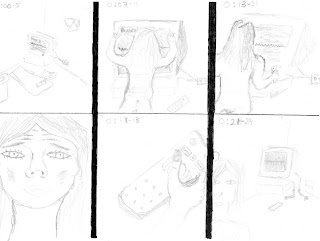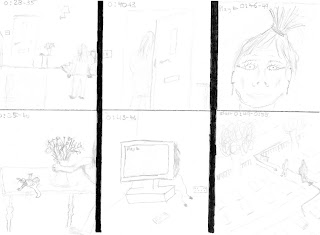



 Another exercise which allows us to consider our
Another exercise which allows us to consider our The second graph shows the user ratings data for 'The Grudge', starring Sarah Michelle-Gellar. Similarly to 'The Ring', it is the male audience that have largely viewed this page, and the males aged 18-29 are once again the largest sub-section. Furthermore, the males aged 30-44 (which had a big further for 'The Ring') have a large effect in this graph.
The second graph shows the user ratings data for 'The Grudge', starring Sarah Michelle-Gellar. Similarly to 'The Ring', it is the male audience that have largely viewed this page, and the males aged 18-29 are once again the largest sub-section. Furthermore, the males aged 30-44 (which had a big further for 'The Ring') have a large effect in this graph.  One of our favourite psychological horrors that we used as research was Steven Spielberg's 'Poltergeist'. As with the previous two, there is the common audience of males between the ages of 18-29 and 30-44. However, one slight difference is that this film appears much less popular with females than 'The Grudge', and this may be down to the protagonist; Sarah Michelle-Gellar plays the main character in 'The Grudge' whereas there are several protagonists in 'Poltergeist', and possibly less emphasis on young women. This supports our choice to place a teenage female as the main person in our film.
One of our favourite psychological horrors that we used as research was Steven Spielberg's 'Poltergeist'. As with the previous two, there is the common audience of males between the ages of 18-29 and 30-44. However, one slight difference is that this film appears much less popular with females than 'The Grudge', and this may be down to the protagonist; Sarah Michelle-Gellar plays the main character in 'The Grudge' whereas there are several protagonists in 'Poltergeist', and possibly less emphasis on young women. This supports our choice to place a teenage female as the main person in our film. 


| Description of what is happening scene by scene | Number of shots in this section Average length of shot |
Titles at the bottom of the screen Ending with the Title of film at the end of the home video APPROX-1min | 3 shots – 3/4secs each approx 4/5 shots – 7-10 secs each approx |
Getting ready to go to mum’s grave Start of supernatural activity APPROX-45secs | 7 shots – 3-9 secs each approx |
Main character at the graveyard Long shot of her going to grave Including unknown hooded figure APPROX-1min
| 2 shots – 8 secs each approx 4 shots – 2-4 secs each approx 3 shots – 7-10 secs each approx |
Main character returns home Supernatural activity increases High angle shot from top of the stair case Hooded figure seen at scene 3 at the end of the garden APPROX-2min 15sec | 4 shots – 3-8 secs each approx 3/4 shots - 2-6 secs each approx 2 shots – 10-15 secs each approx 2/3 shots – 3 secs each approx |
 This first photo shows the use of just one light: the key light. It is focused on one side of the characters face, thus creating dark shadows both behind him and on the opposite side of his body and head.
This first photo shows the use of just one light: the key light. It is focused on one side of the characters face, thus creating dark shadows both behind him and on the opposite side of his body and head. This second image is again created through the use of solely one light, which in this case is the back light. The character stands straight in front of the light to create one large shadow. This technique may be useful in our horror film to create areas of darkness which may be able to move and therefore create tension.
This second image is again created through the use of solely one light, which in this case is the back light. The character stands straight in front of the light to create one large shadow. This technique may be useful in our horror film to create areas of darkness which may be able to move and therefore create tension. This image shows the use of a red gel, which is placed in front of the key light to alter the colour of the shot. It creates a rather evil, sadistic effect, and with the addition of a fill light, one side of the face is more lit than the other.
This image shows the use of a red gel, which is placed in front of the key light to alter the colour of the shot. It creates a rather evil, sadistic effect, and with the addition of a fill light, one side of the face is more lit than the other. This final image shows the use of a fill light (torch), which has been placed behind some paper so as to distribute the light more evenly, stopping the harshness which may come with just the torch. In this case it has created a half of light and a half of shadow, which may well come in useful with our horror.
This final image shows the use of a fill light (torch), which has been placed behind some paper so as to distribute the light more evenly, stopping the harshness which may come with just the torch. In this case it has created a half of light and a half of shadow, which may well come in useful with our horror. 
Analysis of Horror assessment
Introduction:
As practice for our final assessment piece for film we had to remake an existing horror which was made by previous students. After careful planning we managed to shoot the horror, which has a similar plot to the one we were meant to recreate. Then I edited the shots we had taken and put them together to get the best possible ‘continuity’ throughout the film.
Analysis:
If we compare the remake to the original we can see that it has a similar plot and has similar features. The story in both versions is a book which is haunted and causes supernatural things to happen. The main character loses her friend (s) and ends up seeing them dead in the bath. The sequence ends in the bathroom with a shot of her friends alive in the mirror.
The core of the narrative plot in both versions is a sequence of shots taken in the hallway, using close-ups and shots of a long duration to show fear and to build tension.
There is a good variety of shots throughout the film. We managed to put together shots from different angles inside and outside the house, use mirrors to great affect and use close-ups and mid-shots where we thought most appropriate. However, I do believe we could have added some more shots. A high angle shot looking down the stair case could have show how the main character was inferior to the supernatural things occurring in the house. Also, on some shots we zoomed in on characters. This was not very affective in our film. When getting to our final film, we will look at getting rid of these errors. Finally, more shots would have helped with the editing. I feel like we didn’t have enough shots to get perfect continuity. At times (shots of girl walking up the stairs) the continuity was excellent, however, others (girl running down the hallway) weren’t. There aren’t many jumps in the film apparent to the viewer, but I think we still could have made it a lot better with more shots
We succeeded in having good composition throughout the film. The shots include the most relevant elements to the plot. We used the rule of thirds well and made sure that our shots looked picture perfect. Our close up of the hand looking for the die underneath the sofa is probably our best shot, but most of our shots looked very nice.
This ties in well with the mise-en-scene. The light, setting and objects all included in the film were relevant to our horror. Although the light effects which we used were very basic, in the end the film as a whole looked good. We didn’t use very many props; we only used a book and a knife. These were appropriate to the horror genre.
The location we used was also appropriate to the film. It made the main character feel like she was trapped in the narrow hallway and scared in the dimly lit lounge.
Conclusion:
In conclusion, the film looked good, but we still have many things we can improve on. We affectively went from a period of equilibrium to distortion. We built up tension through a series of fast and long shots and used lighting and props well to represent our horror in the right way. We can improve on the quantity and variety of our shots through longer planning. In the end, though, I believe the film worked and it was a good effort for our first film.
Sam Van de Schootbrugge-incentive